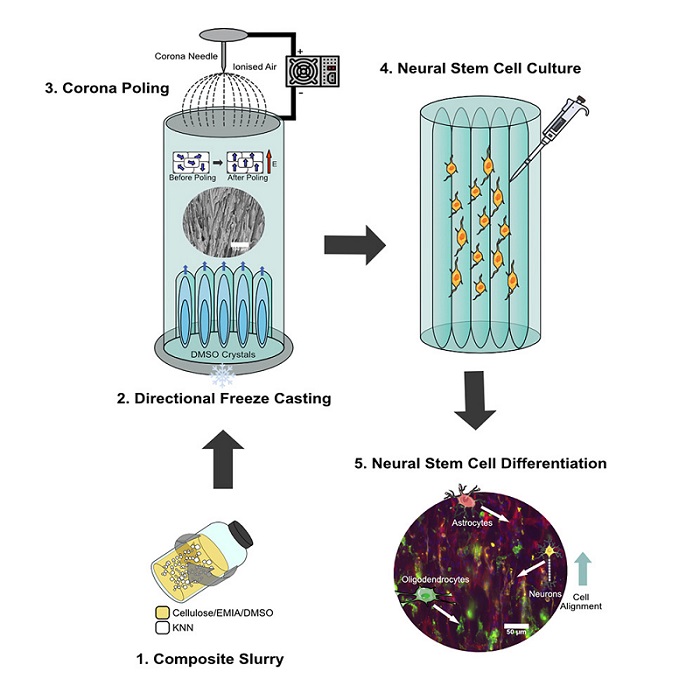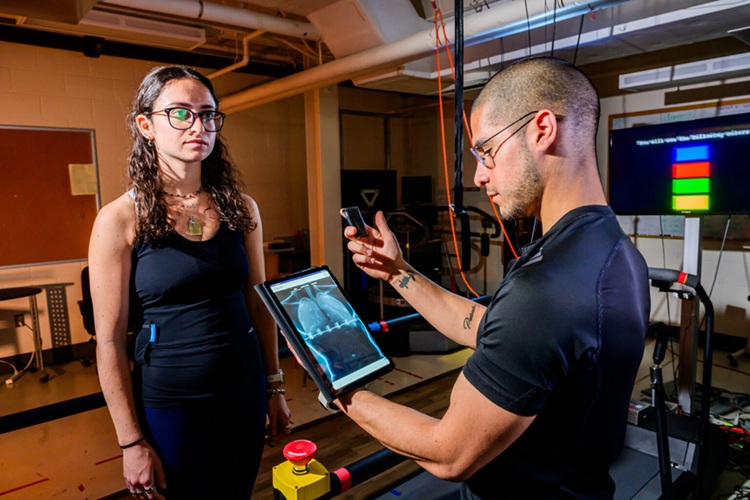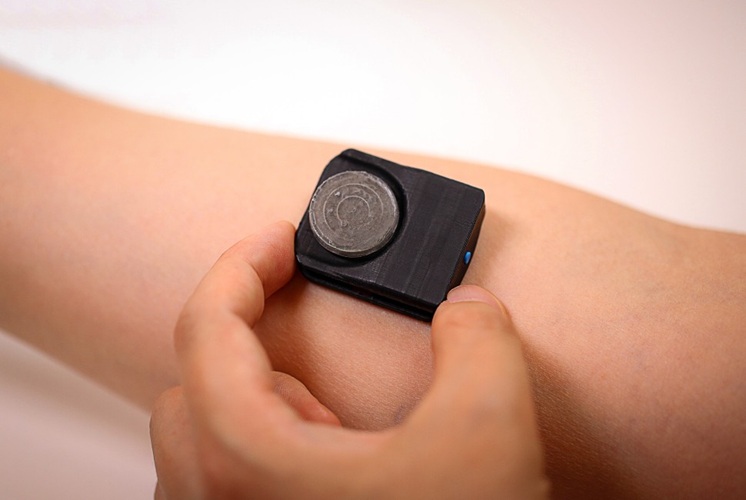Electrically Active Transplantable Material Could Treat Brain and Spinal Cord Injuries
|
By HospiMedica International staff writers Posted on 10 Jan 2025 |

Central nervous system (CNS) injuries, resulting from trauma to the brain or spinal cord, affect millions globally and are some of the most challenging medical conditions to treat. After a traumatic CNS injury, the body’s capacity to regenerate damaged neurons is hampered by an imbalance of growth factors, guidance cues, and inhibitory signals, which delays neural recovery and results in poor clinical outcomes. While treatments like electrical stimulation, topological guidance, and growth factor delivery show promise, a more comprehensive approach is necessary for effectively addressing CNS injuries. Researchers have now developed a new composite material that aids the growth of neural stem cells, offering the potential for treatments targeting CNS injuries and neurodegenerative diseases. Made from cellulose and piezo-ceramic particles, this composite is sustainable and possesses properties that could help repair brain and spinal cord damage. In addition to treating traumatic injuries, it could also be applied to diseases like Alzheimer’s and Parkinson’s Disease.
The new electrically active transplantable material, created by researchers at the University of Bath (Bath, UK) and Keele University (Keele, UK), could significantly improve recovery prospects for patients with life-changing injuries or neurodegenerative conditions. This 3D piezoelectric cellulose composite, described in a research paper published in Cell Reports Physical Sciences, can be used as a personalized ‘scaffold’ to precisely deliver neural stem cells (NSCs) to injury sites, promoting effective repair and regeneration of neurons and surrounding tissues essential for recovery. The composite material is composed of cellulose and potassium sodium niobate (KNN) piezo-ceramic particles. The scaffold implants created from it resemble small, paper-like tubes and can be customized for individual patients. A key feature of the composite’s clinical potential is its multifunctionality and the use of cellulose—a widely-available, sustainable structural component found in plants and algae.
Created through a process called directional freeze casting, the material’s structure is optimized to guide cell growth in a specific direction, as occurs in the spinal cord. This design helps cells repair and reconnect tissue damaged by traumatic injuries, and restore electrical pathways for signal transmission from the brain. Additionally, the material is porous, allowing space for new cells to naturally grow into the structure, simulating the three-dimensional network found in the body. It is also biodegradable by enzymes, meaning it can dissolve within the body once its role is complete. Most importantly, the ceramic microparticles possess piezoelectric properties, generating electrical charges when stressed or moved, thus providing the necessary stimulation for stem cells to grow.
The combination of these properties, and their ability to structure the scaffold, makes this material ideal for delivering neural stem cells and supporting their growth and differentiation into functional neural cells required for repair and recovery. The team of engineers, chemists, and neuroscientists believes the material has the potential to create new treatments aimed at restoring motor, sensory, or cognitive functions in individuals with CNS injuries or neurodegenerative diseases like Alzheimer’s and Parkinson’s. Future developments of the composite and implants will involve tests of biocompatibility and efficacy, further optimization of the materials and freeze-casting methods, scaling up manufacturing, and seeking regulatory approval.
“This is a groundbreaking biomaterial, which has the potential to redefine the prospects of recovery from central nervous system injuries or neurodegenerative diseases. It offers the hope of future treatments that could help patients regain crucial life-changing functions,” said Dr. Hamideh Khanbareh, a senior lecturer in the University of Bath’s Department of Mechanical Engineering. “It also offers clinicians the possibility to create therapeutic tools for treating conditions of this type and establishes a new class of versatile biomaterials that combine mechanical, electrical and biological cues.
Latest Surgical Techniques News
- Intravascular Imaging for Guiding Stent Implantation Ensures Safer Stenting Procedures
- World's First AI Surgical Guidance Platform Allows Surgeons to Measure Success in Real-Time
- AI-Generated Synthetic Scarred Hearts Aid Atrial Fibrillation Treatment
- New Class of Bioadhesives to Connect Human Tissues to Long-Term Medical Implants
- New Transcatheter Valve Found Safe and Effective for Treating Aortic Regurgitation
- Minimally Invasive Valve Repair Reduces Hospitalizations in Severe Tricuspid Regurgitation Patients
- Tiny Robotic Tools Powered by Magnetic Fields to Enable Minimally Invasive Brain Surgery
- Magnetic Tweezers Make Robotic Surgery Safer and More Precise
- AI-Powered Surgical Planning Tool Improves Pre-Op Planning
- Novel Sensing System Restores Missing Sense of Touch in Minimally Invasive Surgery
- Headset-Based AR Navigation System Improves EVD Placement
- Higher Electrode Density Improves Epilepsy Surgery by Pinpointing Where Seizures Begin
- Open-Source Tool Optimizes Placement of Visual Brain Implants
- Easy-To-Apply Gel Could Prevent Formation of Post-Surgical Abdominal Adhesions
- Groundbreaking Leadless Pacemaker to Prevent Invasive Surgeries for Children
- Spectroscopy Technique Improves Surgery for Pediatric Epilepsy Patients
Channels
Critical Care
view channel
Novel Intrabronchial Method Delivers Cell Therapies in Critically Ill Patients on External Lung Support
Until now, administering cell therapies to patients on extracorporeal membrane oxygenation (ECMO)—a life-support system typically used for severe lung failure—has been nearly impossible.... Read more
Generative AI Technology Detects Heart Disease Earlier Than Conventional Methods
Detecting heart dysfunction early using cost-effective and widely accessible tools like electrocardiograms (ECGs) and efficiently directing the right patients for more expensive imaging tests remains a... Read more
Wearable Technology Predicts Cardiovascular Risk by Continuously Monitoring Heart Rate Recovery
The heart's response to physical activity is a vital early indicator of changes in health, particularly in cardiovascular function and mortality. Extensive research has demonstrated a connection between... Read more
Wearable Health Monitoring Device Measures Gases Emitted from and Absorbed by Skin
The skin plays a vital role in protecting our body from external elements. A key component of this protective function is the skin barrier, which consists of tightly woven proteins and fats that help retain... Read morePatient Care
view channel
Portable Biosensor Platform to Reduce Hospital-Acquired Infections
Approximately 4 million patients in the European Union acquire healthcare-associated infections (HAIs) or nosocomial infections each year, with around 37,000 deaths directly resulting from these infections,... Read moreFirst-Of-Its-Kind Portable Germicidal Light Technology Disinfects High-Touch Clinical Surfaces in Seconds
Reducing healthcare-acquired infections (HAIs) remains a pressing issue within global healthcare systems. In the United States alone, 1.7 million patients contract HAIs annually, leading to approximately... Read more
Surgical Capacity Optimization Solution Helps Hospitals Boost OR Utilization
An innovative solution has the capability to transform surgical capacity utilization by targeting the root cause of surgical block time inefficiencies. Fujitsu Limited’s (Tokyo, Japan) Surgical Capacity... Read more
Game-Changing Innovation in Surgical Instrument Sterilization Significantly Improves OR Throughput
A groundbreaking innovation enables hospitals to significantly improve instrument processing time and throughput in operating rooms (ORs) and sterile processing departments. Turbett Surgical, Inc.... Read moreHealth IT
view channel
Printable Molecule-Selective Nanoparticles Enable Mass Production of Wearable Biosensors
The future of medicine is likely to focus on the personalization of healthcare—understanding exactly what an individual requires and delivering the appropriate combination of nutrients, metabolites, and... Read more
Smartwatches Could Detect Congestive Heart Failure
Diagnosing congestive heart failure (CHF) typically requires expensive and time-consuming imaging techniques like echocardiography, also known as cardiac ultrasound. Previously, detecting CHF by analyzing... Read moreBusiness
view channel
Expanded Collaboration to Transform OR Technology Through AI and Automation
The expansion of an existing collaboration between three leading companies aims to develop artificial intelligence (AI)-driven solutions for smart operating rooms with sophisticated monitoring and automation.... Read more















